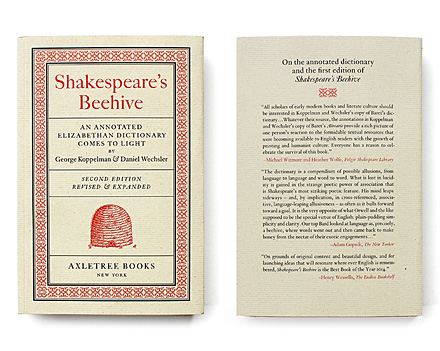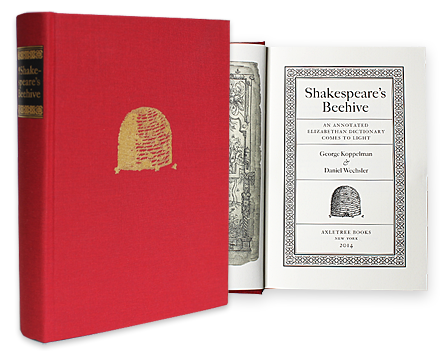June 6, 2014
Baret’s Alvearie: The Biblical Annotations
In our study, Shakespeare’s Beehive: An Annotated Elizabethan Dictionary Comes to Light, we reference twelve biblical annotations as among the most significant of the spoken annotations for several reasons, none more critical than the fact that they have all been born out of the annotator’s memory and do not appear printed in Baret. In comparing the English Bible translations of the period, we observe that, without exception, whenever a translation differs, our annotator’s biblical citations are closer to the Great Bible translation (1540) and the Bishops’ Bible translation (1568). That neither the Geneva (Shakespeare’s clear Bible of choice in the second half of his career) nor the yet-to-be printed King James Bible (1611) were in the annotator’s head is significant, improving our ability to narrow the time frame to which the annotations date.
As far as Shakespeare is concerned, after the composition of Henry V, the biblical allusions turn sharply to the Geneva Bible,[i] but before 1600 the echoes are notably not from the Geneva translation. According to Jonathan Bate, an allusion to the officially sanctioned Bishops’ Bible over the Geneva “would have come from the memory of listening in church.”[ii]
In Shakespeare’s Religious Background, Peter Milward writes, “when he uses the phraseology of the Psalms, it has been noted that Shakespeare follows the Great Bible, as used for the Psalms in the Book of Common Prayer.”[iii]
Our annotator has not copied his biblical citations out of a printed book, as there are frequent minor differences in spelling or wording. It reinforces the very critical point we argue and emphasize when discussing them at various times in our study: these annotations installed in the margins are memories specific of hearing the Great Bible and Bishops’ Bible being read in church. This is essential information when considering the proposed dating of the annotations. In lieu of the inexact science that is paleography, a calculation for the annotations being from a time after the First Folio is highly questionable on the basis of the biblical annotations alone.
We very recently discovered a thirteenth biblical annotation, this one referencing the 32nd Psalm, and it too fit the pattern of echoing the Great Bible and Bishops’ Bible over the Geneva and King James translations. Unlike most of the others, it does not receive a citation of chapter and verse. Let us look at the annotation in our Baret, and the phrase as it appears in the four translations.
D1321. adds “drought in sommer”
Great Bible: “Drouth in Sommer”
Bishops’ Bible: “Drouth in Sommer”
Geneva Bible: “Drought of Summer”
King James Bible: “Drought of Summer”
The use of “in” (Great Bible, Bishops’ Bible), as opposed to “of” (Geneva Bible, King James Bible), may on the surface seem small, but only if one is inclined to dismiss the importance of the biblical translations can it ultimately be argued as such. While we missed including it among the biblical annotations recorded in our study, we did make note of the line receiving a twist in the very early work, Titus Andronicus, not realizing at the time of our recording the echo of Psalm 32.
Titus Andronicus. Titus(3.1.16–22; Q1594, E3–E3b)
O earth I will befriend thee more with raine,
That shall distill from these two auntient ruines,
Then youthfull Aprill shall with all his showres
In summers drought, Ile drop vpon thee still,
In winter with warme teares Ile melt the snow,
And keepe eternall spring time on thy face,
So thou refuse to drinke my deare sonnes blood.
A number of the other twelve biblical annotations from the margins of our Baret are discussed in our study. One in particular that we expected would raise more eyebrows than it has, at least to this juncture, is the one from Psalm 46 that is added in the left margin at K87: “he knappeth the speare in sunder”.
We decided that it would be disingenuous not to mention it specifically, because of the whimsical but widespread speculation surrounding a particular set of coincidences that are found in the translation of that psalm as printed in the King James Bible published in 1611. These involve the number “46” as well as this particular passage that our annotator has added in the left margin at K87.
A word that is being remembered and recorded by the annotator (in this case, “knappeth”) is again most critical, as it eliminates both the Geneva and the King James Bible being in the ear at the time of annotation, because both of these translations use cutteth in place of knappeth that is recorded in both the Great Bible and the Bishops’ Bible.
Great Bible (1540) “He breaketh the bowe & knappeth the speare in sonder”
Bishops’ Bible (1568) “He breaketh the bowe, & knappeth the speare in sunder”
Geneva Bible (1587) “He breaketh the bowe and cutteth the speare”
King James (1611) “He breaketh the bow and cutteth the spear asunder”
We expected this would spark attention to a possibility that has been suggested for many years – namely, that in 1610, as the King James Bible translation was nearing completion, many of the celebrated poets of the period may have been consulted informally by the committee of translators for help with the more poetic passages of the Hebrew Bible such as the Psalms and the Song of Solomon.
Because of the set of coincidences in the 46th Psalm, attention especially falls on Shakespeare. If he had been among the poets chosen, and given the 46th Psalm, could he have taken the opportunity to adjust the exact placement of shake (as the 46th word from the beginning) and spear (as the 46th word from the end) as a hidden “signature,” made even more intriguing because he would have been 46 years old at the time? This theme of poets used as KJB translators was even taken up by Rudyard Kipling in his last published story, “Proofs of Holy Writ,”[iv] which portrays Ben Jonson and William Shakespeare happily imbibing in Shakespeare’s garden in Stratford one afternoon and becoming more and more inebriated as they work together to improve the translation of Isaiah 60 that had just been brought down to them by a messenger on horseback from Oxford.
If our annotator did participate in the KJB translation of the 46th Psalm, he obviously then was already familiar with the Bishops’ Bible version and would seem to have chosen to retain the word cutteth from the Geneva Bible in place of the Bishops’ Bible’s knappeth.
As evidence that the 46th Psalm is still a debatable topic, the TLS recently printed a lively exchange on the matter across three issues from December 2011, to January 2012. Their reviewer, who initiated the discussion, concluded, after an exchange of letters, by saying, “No one, certainly not I, would seriously argue for anything except coincidence in all this. Nevertheless, as a matter of logic, it surely has to be either ‘improbable chance’ or ‘improbable design.’”[v] We are in accord and certainly feel, given the recent illuminating scholarship regarding the known translators of the KJB,[vi] that, at most, with the discovery of our annotated Baret, we may have moved the matter to a chance of slightly less improbable design. That said, it would be difficult to argue the improbability of finding that piece of that psalm in almost any annotated book of the period, let along finding it this annotated copy of Baret’s Alvearie, printed in London in 1580, along with all the other compelling evidence that it holds.
[i] John W. Velz, “Shakespeare and the Geneva Bible: The Circumstances.” In Shakespeare, Marlowe, Jonson: New Directions in Biography, ed. Takashi Kozuka and J. R. Mulryne (Burlington, VT: Ashgate, 2006).
[ii] Bate, Soul of the Age, 138.
[iii] Peter Milward, Shakespeare’s Religious Background (Chicago: Loyola University Press, 1973), 86.
[iv] The Strand magazine, April 1934. “Proofs of Holy Writ” was completed too late to be included in Kipling’s last collection, Limits and Renewals, published in April 1932. It later appeared in The Sussex Edition of the Complete Works in Prose and Verse of Rudyard Kipling (35 vols.) (London: Macmillan, 1937–39).
[v] Stephen Prickett, “Psalm 46,” TLS, January 13, 2012. The series of comments began in the TLS issues of December 23 and 30, 2011, in Prickett’s review of Harold Bloom’s 2011 publication The Shadow of a Great Rock: A Literary Appreciation of the King James Bible.
[vi] David Norton, The King James Bible: A Short History from Tyndale to Today (Cambridge: Cambridge University Press, 2011). This is an example of the scholarship that is currently being devoted to the making of the KJB. The unlikeliness of the notion that the KJB translators who were selected from the leading members of the Anglican and Puritan clergy would have been receptive to including the work of poets who wrote for the theater can be seen in the list of publications of John Rainolds who, in 1599, published Th’ overthrow of Stage-Playes, . . . wherein all the reasons that can be made for them are notably refuted . . . as that the iudgement of any man, that is not froward and perverse, may easelie be satisfied. Wherein is manifestly proved, that it is not onely vnlawfull to bee an actor, but a beholder of those vanities. John Rainolds or Reynolds (1549–1607), president of Corpus Christi College, was the leader of the Puritan delegation to the Hampton Court conference (1604) that set the procedures in place for the new translation. Another aspect of recent scholarship is the inspection of the extant and identifiable books from the translators’ libraries. Much can be revealed, of course, by marginal addenda, but also, in at least one case, by the overall contents of the library itself. Greek scholar William Branthwaite left an enormous library of 1,405 books that is almost intact at Gonville and Caius College; in it one finds, surprisingly, an almost complete lack of English literature. Although not mentioned by Norton, this would seem to open the door, if only slightly, to the possibility that informal contact with leading poets might have been advisable as the translation was drawing to an end.
For Beehive Blog updates, follow us on Facebook and Twitter.



